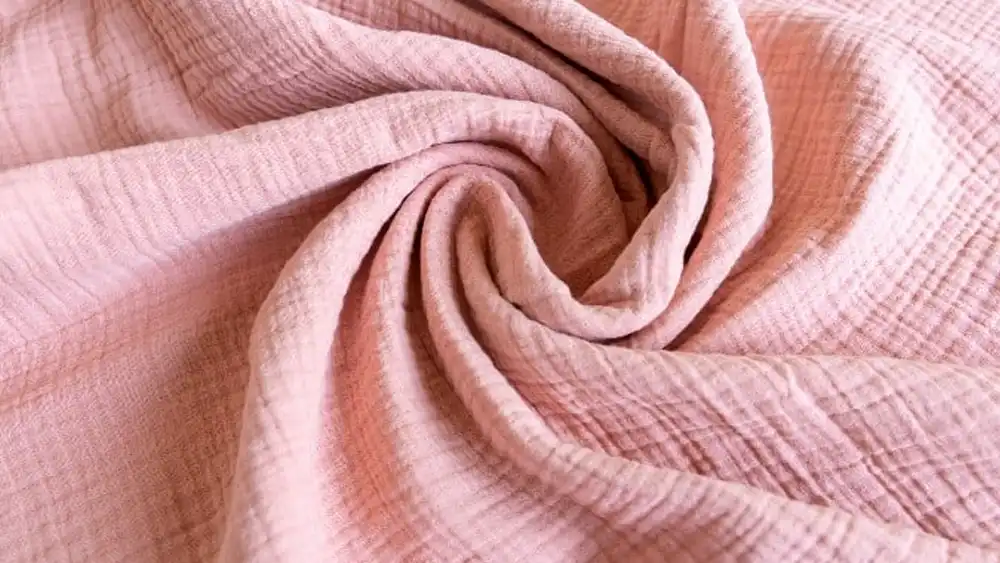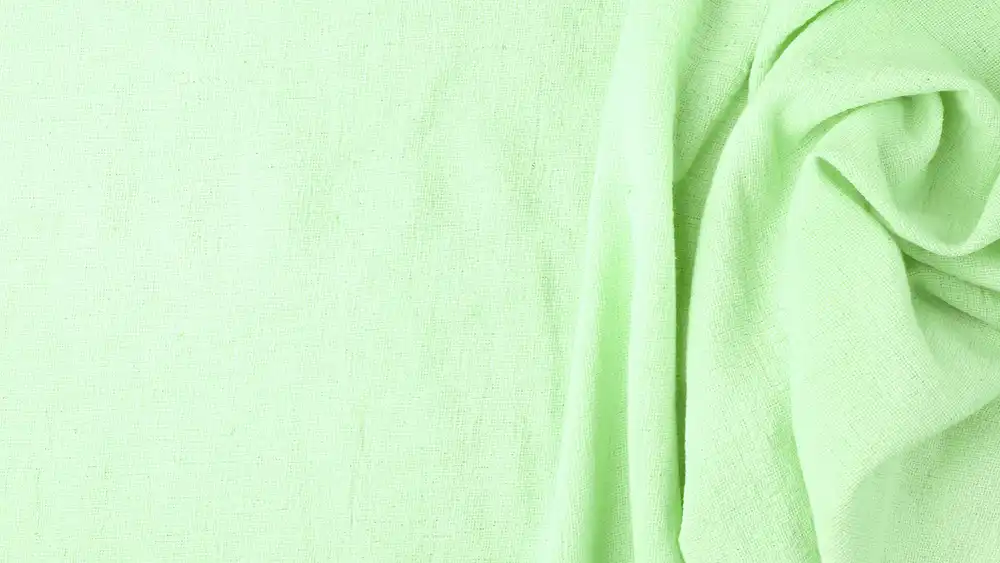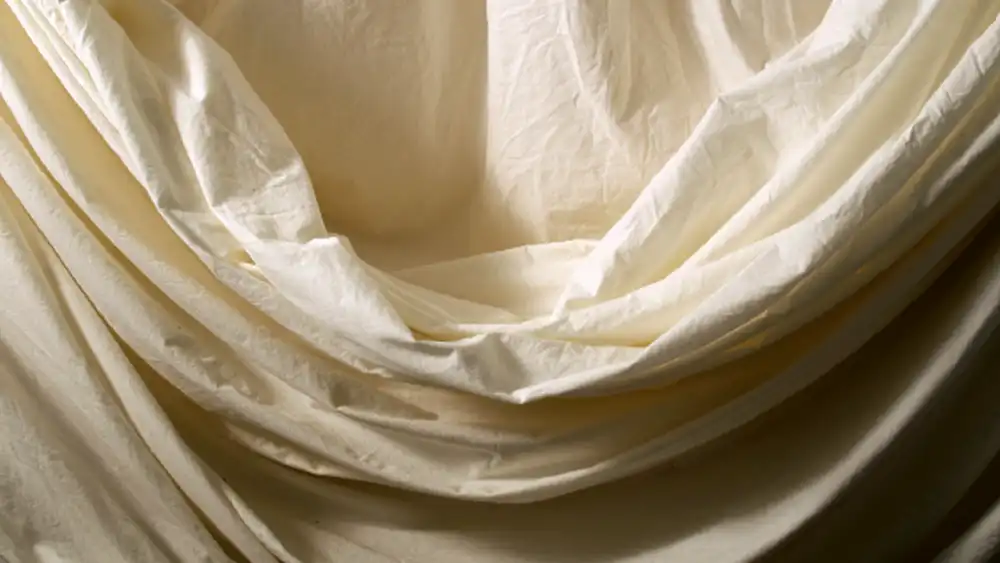You might wonder, what is muslin fabric? Muslin fabric is a lightweight, plain-woven cotton textile known for its soft texture and breathability. In 2025, muslin stands out thanks to its eco-friendly appeal, versatility, and growing demand in fashion, home décor, and even healthcare.
Many people choose muslin for clothing, baby products, and crafts because it feels gentle and natural. Take a look at how the global muslin fabric market is booming this year:

F&A has become a trusted name for high-quality muslin and creative fabric solutions, blending traditional craftsmanship with modern technology to inspire makers worldwide.
Key Takeaways
- Muslin is a soft, lightweight cotton fabric known for its breathability and gentle feel, making it ideal for clothing, baby products, and home décor.
- There are different types of muslin, such as gauze, mull, Swiss, and sheeting, each suited for specific uses, from delicate garments to sturdy upholstery.
- Muslin fabric is easy to care for when washed gently in cool water and air dried, which helps keep it soft and long-lasting.
- Muslin stands out from regular cotton by being softer and more breathable, while it differs from linen by being easier to drape and available in more weights.
- Muslin’s versatility makes it perfect for everyday sewing, crafts, medical uses, and eco-friendly projects, offering endless creative possibilities.
What is Muslin Fabric?

If you have ever wondered what muslin fabric is, you are not alone. Many people ask what muslin is when they see its soft, airy texture in stores or online. Muslin fabric is a lightweight, plain-woven cotton textile that feels gentle against your skin. You will notice its breathability and softness right away.
The plain weave structure means the threads cross over and under each other in a simple, even pattern. This gives muslin its signature lightness and strength.
You might find muslin in many forms, from sheer and delicate to sturdy and thick. The fabric’s versatility makes it a favorite for clothing, home décor, and crafts. When you touch muslin, you can feel its natural comfort and see why it has stayed popular for centuries.
Today, F&A brings you muslin fabric that blends traditional craftsmanship with modern technology. Their team uses advanced looms and finishing techniques to create muslin that meets high standards for quality and creativity.
Origins of Muslin
Let’s take a quick journey back in time to discover where muslin comes from. The name muslin traces back to the city of Mosul in Iraq, a famous trading center for fine cloth.
However, most historians agree that the true birthplace of muslin fabric is the Bengal region, especially around Dhaka in present-day Bangladesh. Here, skilled artisans spun and wove the finest cotton into muslin, using ancient techniques passed down through generations.
In the 17th and 18th centuries, muslin became a prized fabric in Europe. Royals and fashion lovers adored its sheer, delicate quality. The Mughal Court in India reserved the best muslin for royalty, and European markets could not get enough of this luxurious textile.
The French even called it “mousseline,” a word that hints at its light, airy feel. Over time, muslin fabric became a symbol of elegance and comfort, influencing fashion trends across continents.
Did you know? Muslin was so fine and transparent that people called it “woven air.” Some pieces were so delicate, they could pass through a ring!
How Muslin Fabric is Made?

Now, let’s look at how muslin fabric comes to life. The process starts with high-quality cotton, often from special plants like the Phuti karpas in Bangladesh. Artisans spin the cotton into fine yarns, then weave them together using a plain weave. This simple structure gives muslin its signature softness and breathability.
Traditionally, women spun the yarn while men wove the fabric on handlooms. The process required patience and skill, especially for the thinnest, most luxurious muslin.
Today, companies like F&A use state-of-the-art airjet looms and advanced finishing methods. These modern tools help create muslin fabric that is both beautiful and durable. F&A’s team also uses mercerizing and preshrinking to make sure your muslin stays soft and keeps its shape after washing.
Muslin fabric comes in many weights and finishes. You can find it as sheer gauze for baby blankets or as sturdy sheeting for home décor. Some muslin is dyed or printed with colorful patterns, while others stay natural and unbleached.
The fabric’s unique qualities—softness, breathability, and a gentle creased texture—come from the type of cotton, the size of the threads, and the care taken during weaving.
If you are searching for what is muslin fabric that meets modern needs, F&A offers a wide range of options. Their blend of traditional skills and innovative technology means you get muslin that is perfect for any project, from fashion to crafts to home décor.
Muslin Fabric Characteristics
Texture and Feel
When you touch muslin, you notice its gentle, smooth surface right away. The texture feels soft and comforting, making it a favorite for clothing and baby products. F&A uses advanced finishing processes like mercerizing and preshrinking to give their muslin fabric a glossy, silky touch.
These steps help the fabric stay smooth and keep its shape after washing. You can find muslin in different textures, from sheer and delicate to crisp and sturdy. The carding process aligns the cotton fibers, which creates an even, pleasant feel. If you want a fabric that feels natural and cozy, muslin is a great choice.
Tip: Try running your hand over a piece of muslin. You’ll feel the difference compared to other fabrics—muslin’s softness stands out!
Breathability and Weight
Muslin stands out for its breathability. The plain weave structure lets air flow easily, so you stay cool and comfortable. This makes muslin perfect for summer clothes, swaddles, and curtains. You can choose from lightweight gauze muslin to heavier sheeting muslin, depending on your needs.
F&A’s weaving methods, using both handlooms and power looms, create muslin fabric that balances lightness with strength. The fabric’s weight varies, but even the thickest muslin feels airy. You get a fabric that keeps you comfortable in any season.
Durability
You might think muslin looks delicate, but it’s stronger than it seems. The use of long-staple cotton, like Egyptian or Pima, gives muslin extra durability. F&A’s quality control team checks every yard for defects, making sure you get high-quality muslins every time.
The spinning and weaving techniques create a fabric that resists tearing and holds up to repeated washing. Post-weaving finishing, like washing and bleaching, removes impurities and gives muslin a clean, even look. When you choose muslin, you get a fabric that lasts, whether you use it for crafts, clothing, or home décor.
Different Types of Muslin

When you start exploring the world of muslin, you’ll notice there are several different types of muslin, each with its own look and feel. These types suit a wide range of projects, from delicate baby blankets to sturdy home décor. Let’s break down the main types so you can pick the perfect muslin fabric for your next idea.
Here’s a quick table to help you compare the different types of muslin:
| Type | Weight | Texture | Fiber Content | Typical Uses |
|---|---|---|---|---|
| Gauze | Ultra-lightweight | Sheer | Cotton | Clothing, kitchen filters, wound dressing |
| Mull | Lightweight | Plain | Cotton, silk, viscose | Dress underlining for structure |
| Swiss Muslin | Lightweight | Sheer with raised patterns/dots | Cotton | Warm-weather clothing, decorative projects |
| Sheeting | Heaviest | Coarse | Cotton | Clothing, upholstery, home décor, backdrops |
Gauze Muslin
Gauze muslin feels airy and almost see-through. You’ll find it ultra-lightweight, with a loose weave that lets air pass through easily. This fabric works well for summer clothing, kitchen filters, and even medical uses like wound dressings.
If you layer gauze muslin, it can filter out particles, which makes it handy for DIY masks or crafts. F&A offers gauze muslin in both natural and printed styles, so you can get creative with your projects.
Mull Muslin
Mull muslin gives you a soft, plain texture. It’s lightweight and often made from cotton, silk, or viscose. You’ll see mull used as a dress underlining, adding structure without bulk.
This type of muslin fabric helps shape garments and keeps them comfortable. F&A’s custom fabric service lets you choose the fiber blend and finish, so you get exactly what you need for fashion or costume design.
Swiss Muslin
Swiss muslin stands out with its sheer look and tiny raised dots or patterns. This fabric feels light but has a bit more structure, making it perfect for warm-weather clothing and decorative home projects.
You might use Swiss muslin for curtains, blouses, or even special event décor. F&A’s in-house collection features Swiss muslin with unique patterns inspired by both tradition and modern trends.
Sheeting Muslin
Sheeting muslin is the heaviest of the different types of muslin. It feels coarser and more durable, so you’ll often see it in upholstery, home décor, or theatrical backdrops.
This fabric holds up well to repeated use and washing. F&A produces sheeting muslin in a range of widths and colors, making it easy for you to find the right fit for larger projects.
Tip: If you want something truly unique, F&A’s custom printing and dyeing services let you design your own muslin fabric. Try organic or recycled muslin for a sustainable touch!
Muslin keeps evolving. Today, you can find organic, recycled, and multifunctional muslin fabrics thanks to new technology and eco-friendly practices. F&A leads the way by offering both traditional and innovative muslin options, so you always have the best materials for your creative journey.
Uses of Muslin
Muslin stands out as one of the most versatile fabrics you can use today. Whether you want to sew, decorate, or create something unique, you’ll find muslin used for all sorts of projects. Let’s explore how you can bring this timeless fabric into your daily life, creative hobbies, and even specialized industries.
Everyday and Home Uses
You probably see muslin used for many everyday tasks at home. People love this fabric for making clothing, curtains, and bedding because it feels soft and lets air flow easily. Many home sewers choose muslin fabric to practice new patterns or test garment fits.
In a recent sewing study, most participants preferred muslin for practice because it was easy to handle and helped them improve their skills. They found that muslin made it simple to try new techniques and fix mistakes without worry.
You can also use muslin for kitchen tasks, like straining liquids or covering dough, thanks to its lightweight weave.
- Muslin is perfect for:
- Prototyping sewing projects
- Making reusable produce bags
- Lining drawers or shelves
- Creating lightweight curtains
Tip: If you want to boost your sewing skills, try practicing on muslin first. It’s affordable and forgiving, making it a favorite for beginners and experts alike.
Crafts and DIY Projects
If you love crafts, you’ll find muslin used for everything from tie-dye to embroidery. Artisans have relied on muslin fabric for centuries, using it as a base for dyeing, printing, and embellishing. You can pleat, crimp, or embroider muslin to create one-of-a-kind pieces.
Traditional crafts like Bandhani tie-dye and Chikankari embroidery show just how creative you can get with this fabric. F&A partners with DIY enthusiasts and major brands, offering custom muslin options that let you bring your ideas to life.
- Muslin works well for:
- Hand-painted wall hangings
- Custom tote bags
- Quilting and patchwork
- Theatrical costumes
Industrial and Medical Uses
Muslin fabric has a long history in medical and industrial settings. Hospitals once used muslin for surgical gowns and drapes because it was easy to sterilize and acted as a barrier when dry. Today, you’ll still see muslin used for bandages, wound dressings, and even in advanced applications like microencapsulation.
Scientists have infused muslin with lavender oil to help patients relax and sleep better. These innovations show how muslin keeps evolving, meeting new needs in healthcare and industry.
Note: F&A’s commitment to quality and innovation means you always get muslin that’s ready for any project, big or small.
Caring for Muslin
Washing and Drying
You want your muslin to stay soft and last a long time. Always wash muslin in cool or lukewarm water. Use a gentle detergent and avoid bleach, which can weaken the fibers. If you use a washing machine, pick the delicate cycle. For best results, hand wash your muslin and rinse it well.
When it comes to drying, lay the fabric flat on a clean towel or hang it up to air dry. Skip the dryer if you can, since high heat may shrink or damage the fabric. If you need to iron your muslin, use a low heat setting and press while the fabric is still slightly damp.
Storage Tips
Proper storage keeps your muslin looking fresh and protects it from pests and damage. A recent study found that black muslin, when combined with botanicals like neem and exposed to sunlight, can help control pests naturally. Here’s a quick look at the results:
| Parameter | Black Muslin + Botanicals + Sun | White Muslin + Botanicals + Sun |
|---|---|---|
| Pest Mortality | 100% after 48-72 hours | Lower due to heat reflection |
| Egg Laying | Significantly reduced | Higher egg counts |
| Seed Weight Loss | Much lower than the control | Higher than black muslin |
For everyday storage, keep your muslin in a cool, dry place. Avoid attics, basements, or garages, since these spots can attract mold and insects. Use acid-free boxes or roll large pieces around acid-free tubes.
Cover your muslin with unbleached muslin bags or dust covers to keep out dust and light. Try to store your fabric flat to prevent creases.
Preventing Damage
You can keep your muslin in great shape with a few simple steps:
- Store muslin in climate-controlled rooms, away from direct sunlight.
- Use acid-free tissue paper to pad folds and prevent creasing.
- Handle muslin with clean hands or cotton gloves.
- Avoid plastic bags and overpacking.
- Keep the storage temperature around 65-70°F.
If you have antique or valuable muslin, avoid washing it. Instead, consult a textile expert for the best care. These habits help your muslin stay beautiful and ready for your next project.
Muslin vs Other Fabrics
Muslin vs Cotton
You might wonder how muslin fabric compares to regular cotton. Both come from cotton plants, but muslin fabric stands out because of its plain weave and gentle finish. Scientific studies show that muslin fibers change after special treatments, becoming flatter and whiter than untreated cotton.
This process gives muslin fabric its ultra-soft feel and makes it gentle on sensitive skin. Cotton, in its basic form, is a bit sturdier and easier to care for, but muslin fabric feels lighter and more breathable.
Here’s a quick comparison:
| Feature | Muslin Fabric | Cotton (General) |
|---|---|---|
| Softness | Ultra-soft, gentle | Varies, usually soft |
| Breathability | Excellent, lightweight | Good |
| Durability | Moderate, softer texture | Durable |
| Care | Needs gentle washing | Easier care |
| Usage | Bedding, clothing, crafts | Everyday textiles |
Tip: If you want a fabric for baby clothes or summer bedding, muslin fabric is a top pick for comfort and breathability.
Muslin vs Linen
Linen and muslin fabric both feel cool and airy, but they come from different plants. Linen uses flax fibers, while muslin fabric uses cotton. Linen feels smooth and gets softer over time.
It also lasts longer and holds color better. Muslin fabric, on the other hand, is easier to drape and comes in a wider range of weights. Linen is more eco-friendly, using less water and fewer chemicals during production.
| Aspect | Muslin Fabric (Cotton-based) | Linen (Flax-based) |
|---|---|---|
| Fiber Source | Cotton yarns, loosely woven | Flax fibers |
| Water Usage | High | Low |
| Environmental | Higher resource use | More sustainable |
| Feel | Soft, breathable, versatile | Smooth, luxurious, durable |
| Applications | Fashion, baby care, home textiles | Fashion, home, luxury |
Note: Linen is great for hot, humid climates and for anyone who wants a long-lasting, eco-friendly fabric.
Choosing the Right Fabric
Picking the best fabric depends on what you need. If you want something soft, lightweight, and easy to sew, muslin fabric is a great choice. Cotton works well for everyday clothes and is easy to care for. Linen is perfect if you want a fabric that lasts, feels cool, and is kind to the planet.
Here’s a quick guide:
| Property | Best For |
|---|---|
| Breathability | Muslin, Linen |
| Durability | Linen, Cotton |
| Hypoallergenic | Muslin |
| Eco-friendly | Linen |
| Easy Care | Cotton |
Think about your project, the climate, and how much care you want to give your fabric. You can always try samples to see what feels best for you!
Conclusion
Muslin brings you softness, breathability, and endless possibilities. In 2025, you see it everywhere—from fashion to crafts—because it stays fresh and reliable. F&A stands by quality, eco-friendly practices, and creative inspiration. You can trust their muslin for any project.
Ready to get creative? Try muslin for your next DIY or fashion idea. You might surprise yourself with what you can make! ✂️
FAQ
What makes muslin fabric different from regular cotton?
Muslin uses a plain weave and feels softer and lighter than most cotton fabrics. You get more breathability and a gentle touch. Many people choose muslin for baby products and summer clothes because it feels cool and comfortable.
Can I dye or paint on muslin fabric?
Yes! Muslin takes dye and paint very well. You can create custom colors or designs for crafts, costumes, or home décor. Just wash the fabric first to remove any finish. Then, let your creativity shine.
How do I stop muslin from shrinking?
Wash muslin in cool water and air dry it. F&A’s muslin comes preshrunk, so you don’t have to worry as much. If you use other brands, test a small piece first. Avoid high heat when drying or ironing.
Is muslin fabric safe for sensitive skin?
Absolutely. Muslin feels soft and gentle, making it a top pick for babies and people with sensitive skin. F&A uses high-quality cotton and advanced finishing, so you get a fabric that feels smooth and safe.
Where can I buy high-quality muslin fabric?
You can find premium muslin at F&A’s online store or through major retailers like Amazon, Walmart, and Joann. F&A offers a wide range of muslin types, custom prints, and eco-friendly options for every project.
